Research on a Fault Diagnosis Method for Crankshafts Based on Improved Multi-Scale Permutation Entropy
Abstract
1. Introduction
2. Algorithm Principle
2.1. ICEEMDAN Algorithm
- (1)
- Add white noise to the original signal :
- (2)
- Calculate the first decomposition residual:
- (3)
- Calculate the first-order modal component :
- (4)
- Calculate the th-order residuals :
- (5)
- Calculate the th-order modal component :
- (6)
- Let return (5) to calculate the next .
2.2. Improved MPE
2.2.1. Permutation Entropy
- (1)
- Assuming is a one-dimensional time series, phase-space reconstruction is performed on the one-dimensional time series:
- (2)
- The components obtained by reconstructing each row of the matrix are sorted as follows:
- (3)
- For an -dimensional reconstructed phase space, each set has a total of ordering possibilities. The number of occurrences of each sort are counted and their probabilities, , are computed with:
- (4)
- According to the defining equation of Shannon’s entropy, the permutation entropy is obtained as:
2.2.2. MPE
- (1)
- As shown in Figure 1, the time series is divided into a window with a length of .
- (2)
- The time series is coarsened as follows:
- (3)
- An -dimensional phase-space reconstruction is carried out for the coarse-granulated sequences :
- (4)
- The reconstructed components are sorted in ascending order:
- (5)
- The permutation entropy value of the coarse-grained lagging sequence is calculated using Equation (10), and then normalized through Equation (11) to obtain the MPE:
2.2.3. Optimization of MPE Parameters by Genetic Algorithm
- (1)
- Load the original signal, set the parameters to be optimized, and initialize the parameters of the multi-scale permutation entropy algorithm.
- (2)
- Take the square function of the multi-scale permutation entropy skewness as the fitness function, and calculate the skewness of the permutation entropy sequence under all scales of the time series as follows:
- (3)
- The objective function is:
- (4)
- Carry out crossover, variation, selection and other operations.
- (5)
- Judge whether the termination conditions are met. If yes, output the results; otherwise, go to the previous step (4).
2.3. PSO-Based SVM Parameter Optimization
2.4. Troubleshooting Process
3. Numerical Simulation
3.1. 3D Modeling of Shafting
3.2. Dynamic Simulation
4. Experimental Verification
5. Conclusions
Author Contributions
Funding
Institutional Review Board Statement
Informed Consent Statement
Data Availability Statement
Conflicts of Interest
References
- Fonte, M.; Freitas, M.; Reis, L. Failure analysis of a damaged diesel motor crankshaft. Eng. Fail. Anal. 2019, 102, 1–6. [Google Scholar] [CrossRef]
- Fonte, M.; Anes, V.; Duarte, P.; Reis, L.; Freitas, M. Crankshaft failure analysis of a boxer diesel motor. Eng. Fail. Anal. 2015, 56, 109–115. [Google Scholar] [CrossRef]
- Gomes, J.; Gaivota, N.; Martins, R.F.; Silva, P.P. Failure analysis of crankshafts used in maritime V12 diesel engines. Eng. Fail. Anal. 2018, 92, 466–479. [Google Scholar] [CrossRef]
- Yu, K.; Luo, Z.T.; Li, H.F.; Ma, H. General Parameterized Synchrosqueezing Transform and Its Application in Rotating Machinery Vibration Signal. J. Mech. Eng. 2019, 55, 149–159. [Google Scholar] [CrossRef]
- Li, Z. Wear state detection method of rotating machinery based on wavelet transform time-frequency analysis. J. Xinyu Univ. 2022, 27, 13–17. [Google Scholar]
- Zou, J.; Chen, J. A comparative study on time–frequency feature of cracked rotor by Wigner–Ville distribution and wavelet transform. J. Sound Vib. 2004, 276, 1–11. [Google Scholar] [CrossRef]
- Feng, Z.; Liang, M.; Chu, F. Recent advances in time–frequency analysis methods for machinery fault diagnosis: A review with application examples. Mech. Syst. Signal Process. 2013, 38, 165–205. [Google Scholar] [CrossRef]
- Diao, N.; Ma, H.; Wang, J.; Liu, S. Fault diagnosis of rolling bearing based on MPE and PSO-SVM. Electron. Meas. Technol. 2021, 44, 44–48. [Google Scholar]
- Zhou, J.; Li, J.; Yin, W.; You, T.; Xiong, W.; Gao, S. Evaluation of rolling bearing degradation performance based on CEEMDAN and PSO-OCSVM. J. Electron. Meas. Instrum. 2021, 35, 194–201. [Google Scholar]
- Dragomiretskiy, K.; Zosso, D. Variational Mode Decomposition. IEEE Trans. Signal Process. 2014, 62, 531–544. [Google Scholar] [CrossRef]
- Bie, F.; Du, T.; Pang, M.; Gu, S. Research on the Method of Acoustic Signals Recognition for Pipelines based on ICEEMDAN-ELM. Noise Vib. Control 2019, 39, 205–211. [Google Scholar]
- Colominas, M.A.; Schlotthauer, G.; Torres, M.E. Improved complete ensemble EMD: A suitable tool for biomedical signal processing. Biomed. Signal Process. Control 2014, 14, 19–29. [Google Scholar] [CrossRef]
- Yan, R.; Liu, Y.; Gao, R. A nonlinear statistical measure for status characterization of rotary machines. Mech. Syst. Signal Process. 2012, 29, 474–484. [Google Scholar] [CrossRef]
- Zhao, R.; Li, J.; Deng, L. Method Integrate EWT Multi-scale Permutation Entropy with GG Clustering for Bearing Fault Diagnosis. J. Vib. Meas. Diagn. 2019, 39, 416–423, 451. [Google Scholar]
- Zhao, J.; Ning, J.; Ning, Y.; Chen, C.; Li, Y. Feature extraction of mechanical fault diagnosis based on MPE-LLTSA. J. Vib. Shock 2021, 40, 136–145. [Google Scholar]
- He, Y.; Wang, H.; Gu, S. New fault diagnosis approach for bearings based on parameter optimized VMD and genetic algorithm. J. Vib. Shock 2021, 40, 184–189. [Google Scholar]
- Chen, Y.; Rao, M.; Feng, K.; Niu, G. Modified Varying Index Coefficient Autoregression Model for Representation of the Nonstationary Vibration From a Planetary Gearbox. IEEE Trans. Instrum. Meas. 2023, 72, 1–12. [Google Scholar] [CrossRef]
- Chen, Y.; Rao, M.; Feng, K.; Zuo, M.J. Physics-Informed LSTM hyperparameters selection for gearbox fault detection. Mech. Syst. Signal Process. 2022, 171, 108907. [Google Scholar] [CrossRef]
- Lyu, M.; Su, X.; Liu, S.; Chen, C. Degradation State Recognition of Rolling Bearing Based on VMD-SVM. Mach. Des. Manuf. 2020, 96–100. [Google Scholar] [CrossRef]
- Zhao, L.; Cheng, H.; Li, W.; Guan, C. Research on Fault Diagnosis Method of Plunger Pump Based on LMD and Support Vector Machine. Mach. Des. Manuf. 2022, 238–241. [Google Scholar] [CrossRef]
- Xu, Y.; Yan, X.; Sun, B.; Feng, K.; Kou, L.; Chen, Y.; Li, Y.; Chen, H.; Tian, E.; Ni, Q.; et al. Online Knowledge Distillation Based Multiscale Threshold Denoising Networks for Fault Diagnosis of Transmission Systems. IEEE Trans. Transp. Electrif. 2023, 1. [Google Scholar] [CrossRef]
- Xu, Y.; Feng, K.; Yan, X.; Yan, R.; Ni, Q.; Sun, B.; Lei, Z.; Zhang, Y.; Liu, Z. CFCNN: A novel convolutional fusion framework for collaborative fault identification of rotating machinery. Inf. Fusion 2023, 95, 1–16. [Google Scholar] [CrossRef]
- Sharma, S.; Tiwari, S.K.; Singh, S. Integrated approach based on flexible analytical wavelet transform and permutation entropy for fault detection in rotary machines. Measurement 2021, 169, 108389. [Google Scholar] [CrossRef]
- Lei, Y.; Liu, Z.; Ouazri, J.; Lin, J. A fault diagnosis method of rolling element bearings based on CEEMDAN. Proc. Inst. Mech. Eng. Part C J. Mech. Eng. Sci. 2017, 231, 1804–1815. [Google Scholar] [CrossRef]
- Bandt, C.; Pompe, B. Permutation entropy: A natural complexity measure for time series. Phys. Rev. Lett. 2002, 88, 174102. [Google Scholar] [CrossRef] [PubMed]
- Tian, Y.; Wang, Z.; Lu, C. Self-adaptive bearing fault diagnosis based on permutation entropy and manifold-based dynamic time warping. Mech. Syst. Signal Process. 2019, 114, 658–673. [Google Scholar] [CrossRef]
- Wu, W.; Shen, Y.; Yang, S. Feature extraction for nonlinear systems based on permutation entropy theory. J. Vib. Shock 2020, 39, 67–73. [Google Scholar]
- Aziz, W.; Arif, M. Multiscale Permutation Entropy of Physiological Time Series. In Proceedings of the 2005 Pakistan Section Multitopic Conference, Karachi, Pakistan, 23–24 December 2005; pp. 1–6. [Google Scholar]
- Zheng, J.; Pan, H.; Yang, S.; Cheng, J. Generalized composite multiscale permutation entropy and Laplacian score based rolling bearing fault diagnosis. Mech. Syst. Signal Process. 2018, 99, 229–243. [Google Scholar] [CrossRef]
- Tenenbaum, J.B. A global geometric framework for nonlinear dimensionality reduction. Science 2000, 290, 2319–2323. [Google Scholar] [CrossRef]
- Zhao, Y.; Li, K.; Su, L.; Chen, P. Fault Diagnosis Method for Rolling Bearing based on Least Squares Mapping and SVM. J. Mech. Transm. 2017, 41, 165–170. [Google Scholar]
- Trelea, I.C. The particle swarm optimization algorithm: Convergence analysis and parameter selection. Inf. Process. Lett. 2003, 85, 317–325. [Google Scholar] [CrossRef]
- Li, B.; Yang, M. Analysis model of dilling tool failure based on PSO-SVM and its application. In Proceedings of the Fourth International Conference on Computational & Information Sciences, Chongqing, China, 17–19 August 2012; Chongqing University of Science and Technology: Chongqing, China, 2012; pp. 1307–1310. [Google Scholar]
- Liu, J.C.; Wang, H.T.; Zeng, S.P.; Yuan, Z.G. Intelligent evaluation model for cementing quality based on PSO-SVM and application. Appl. Mech. Mater. 2011, 71–78, 4293–4299. [Google Scholar] [CrossRef]
- Xu, J. Strength of Materials; Shanghai Jiao Tong University Press: Shanghai, China, 2009; pp. 212–220. [Google Scholar]
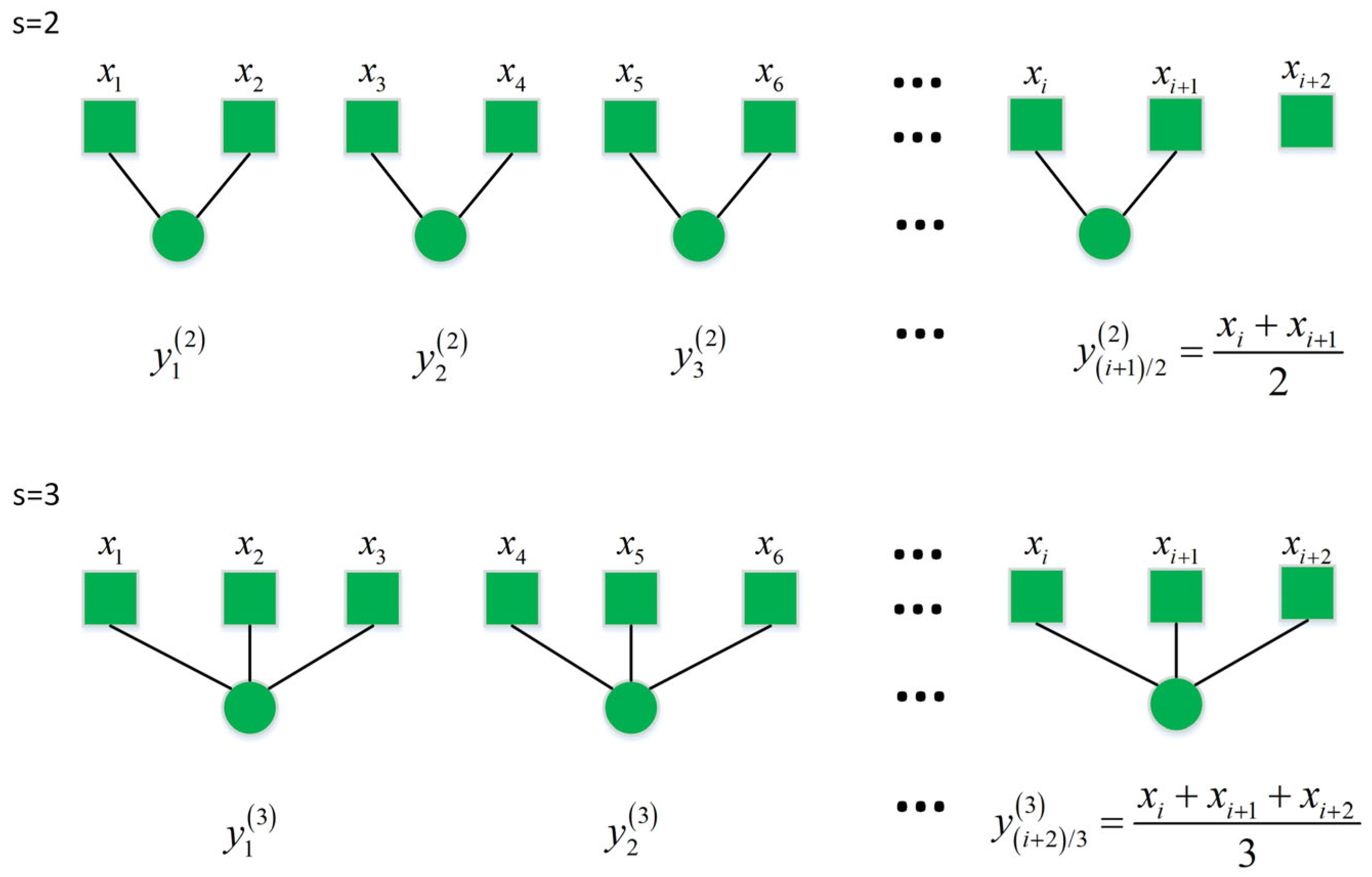
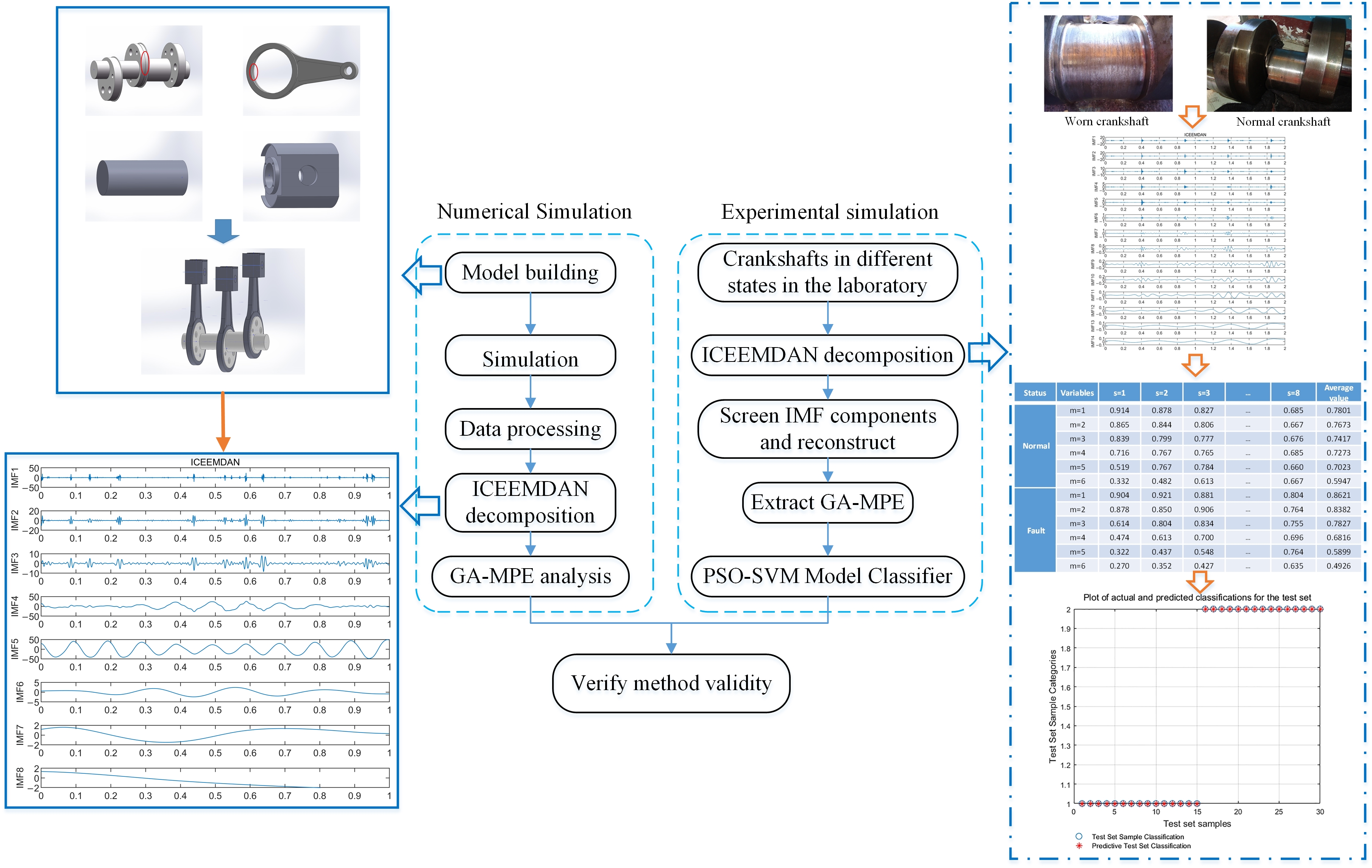
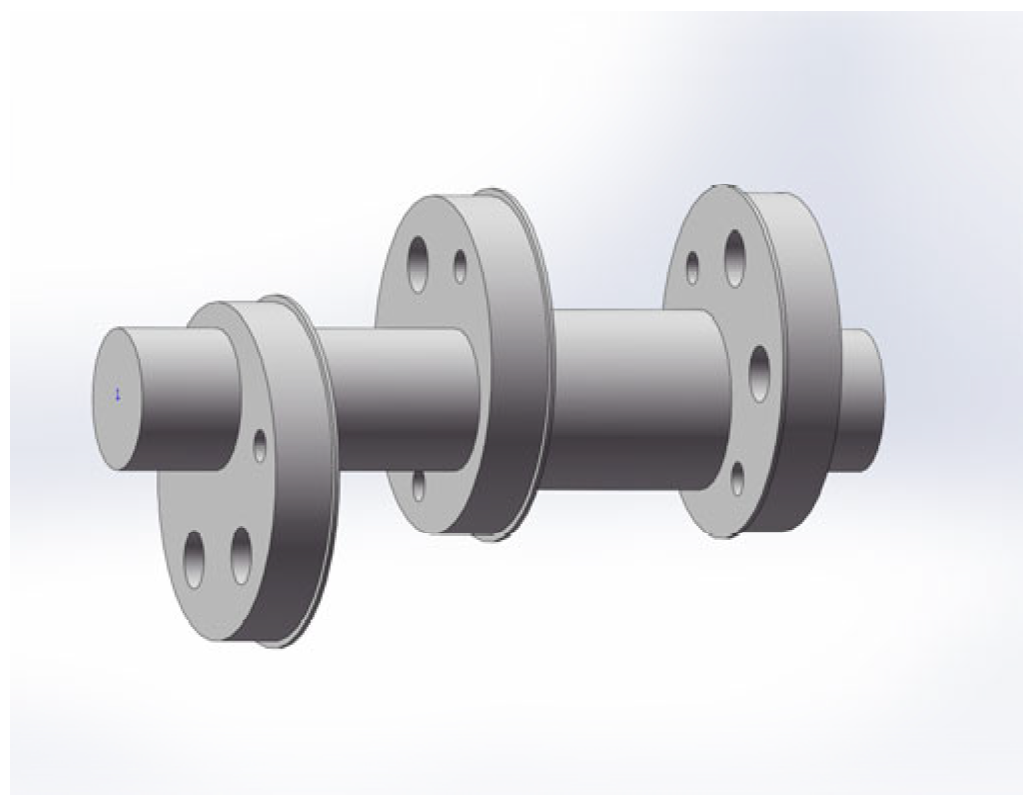
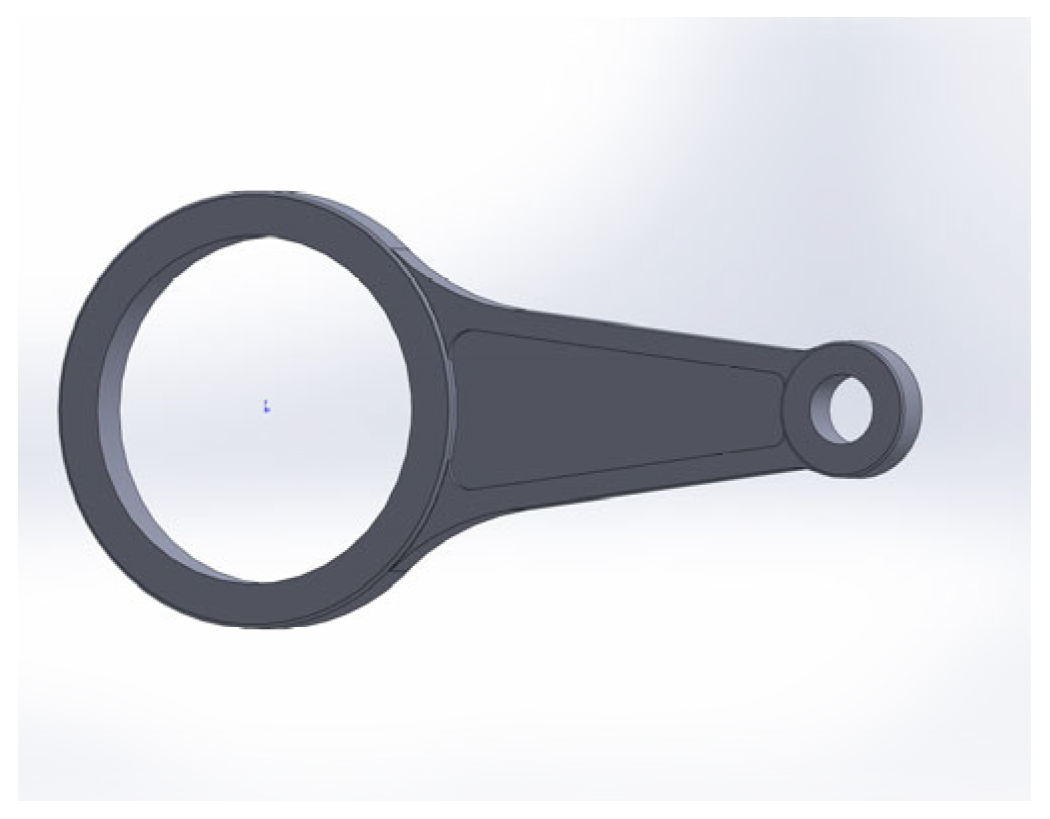
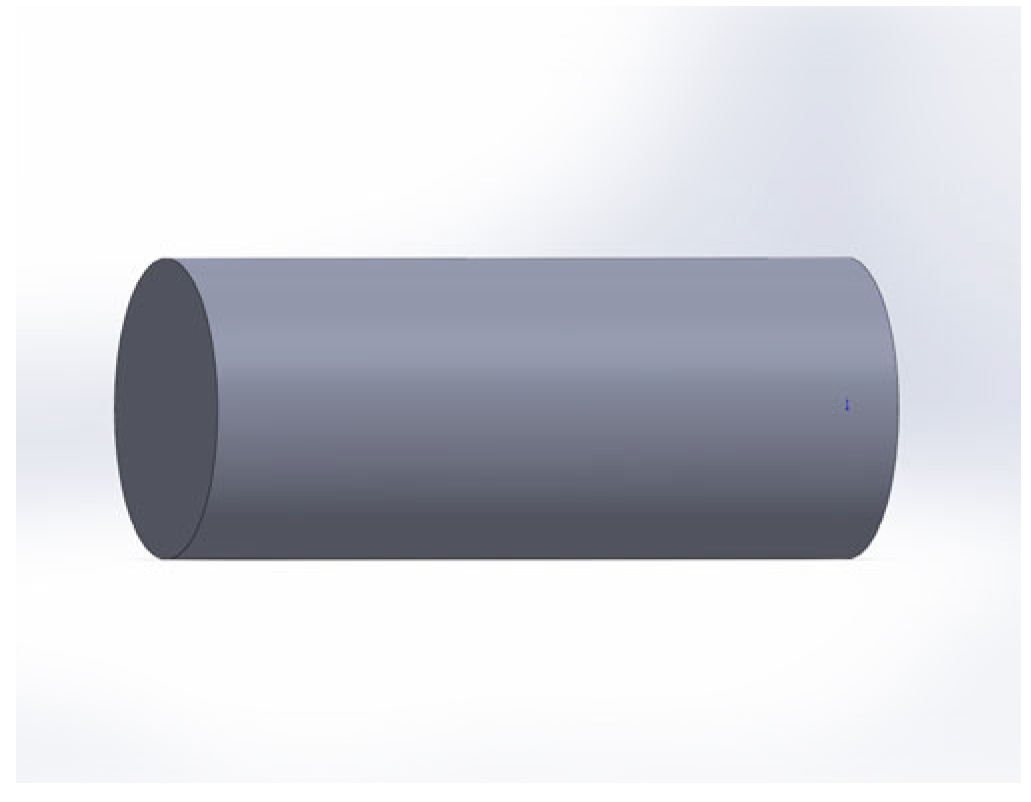
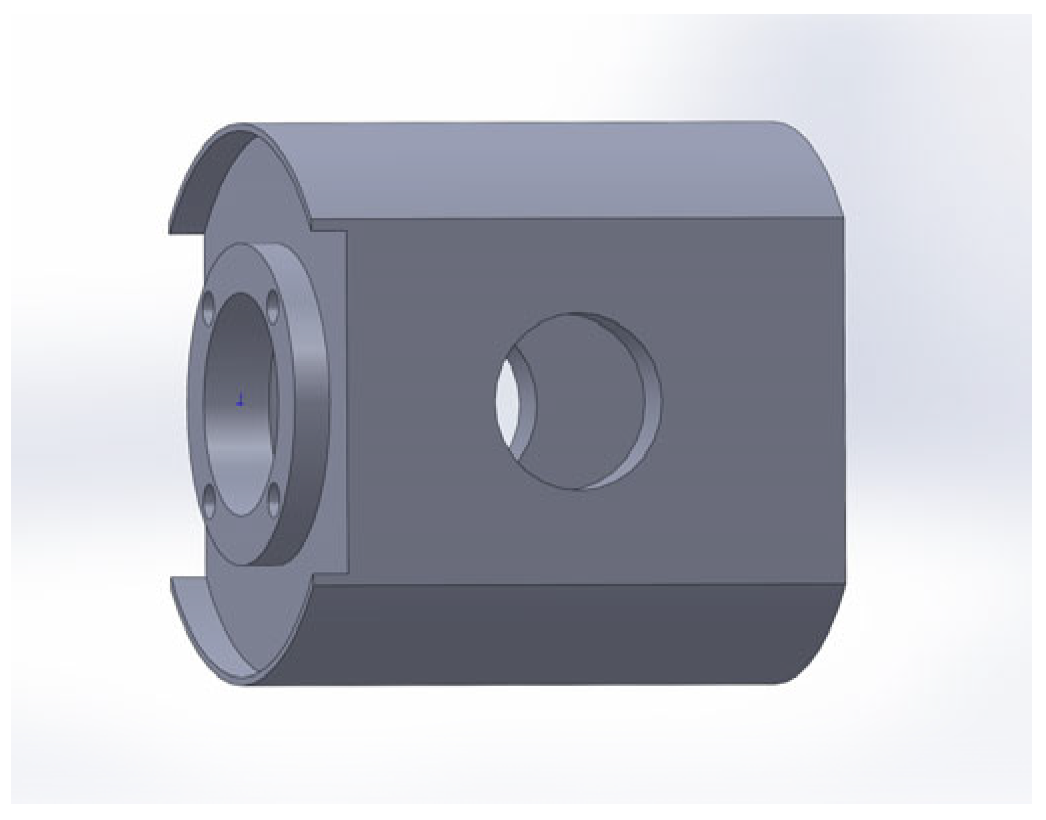
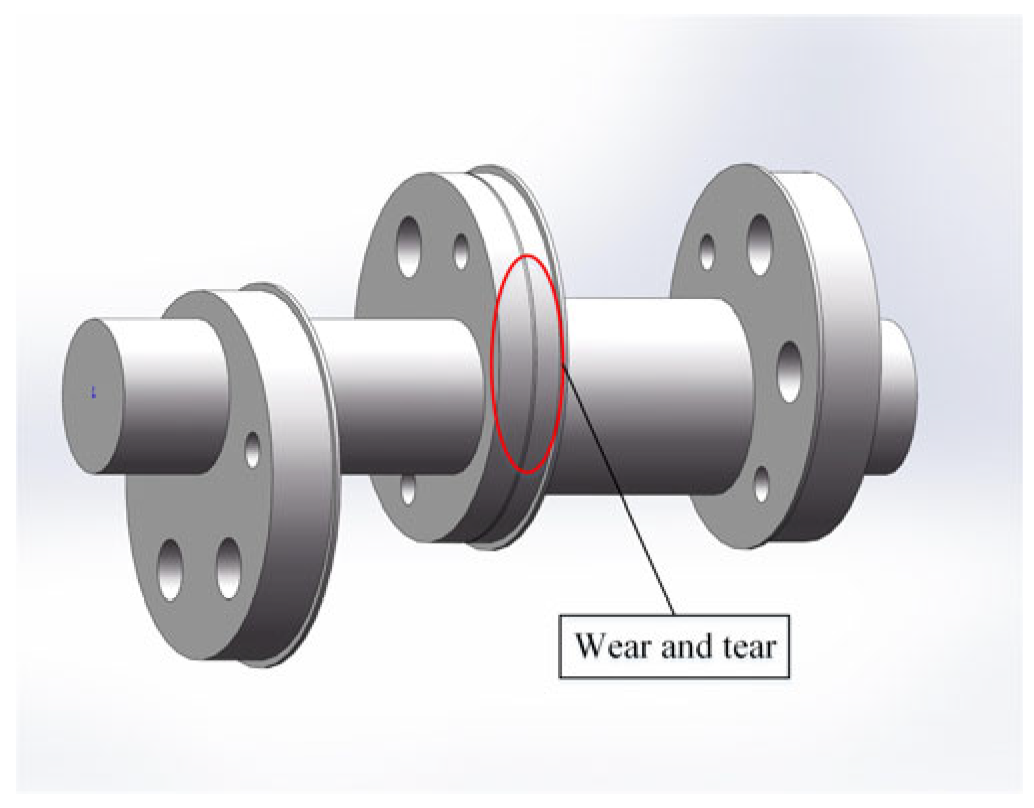
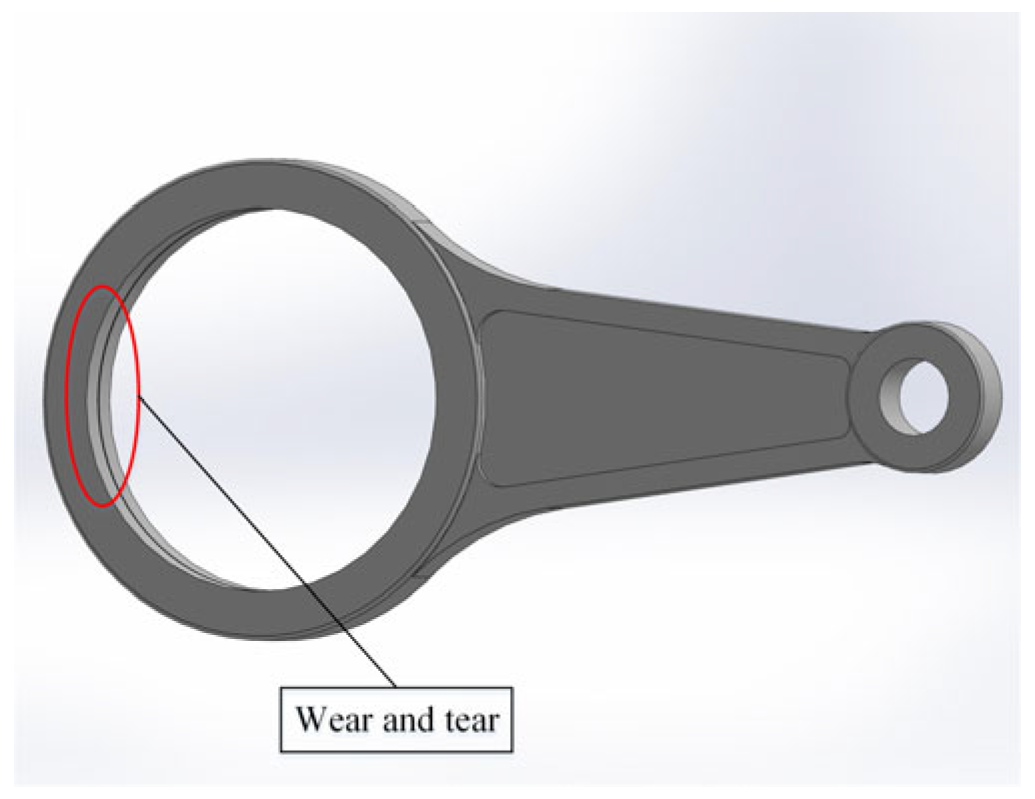


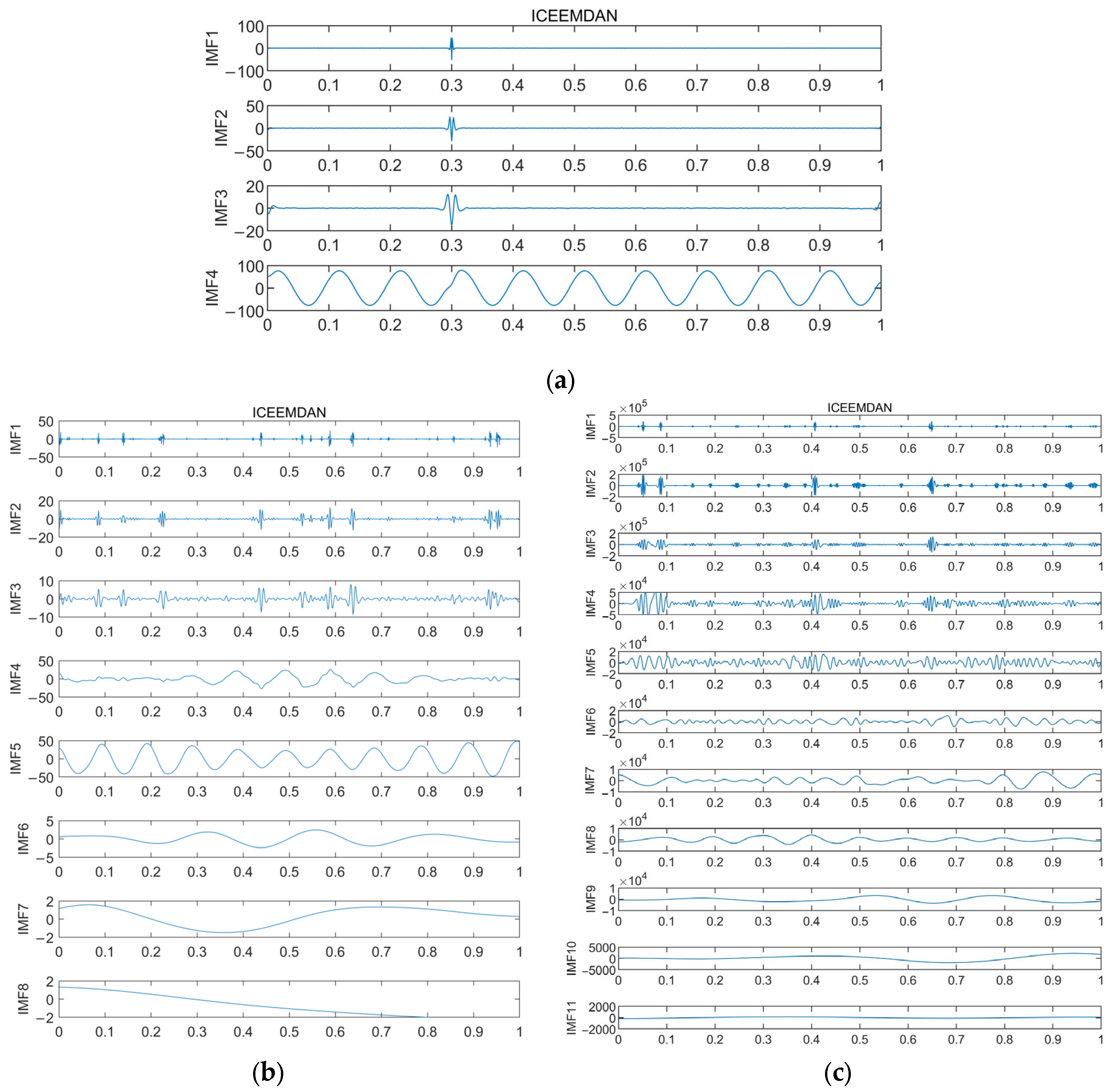
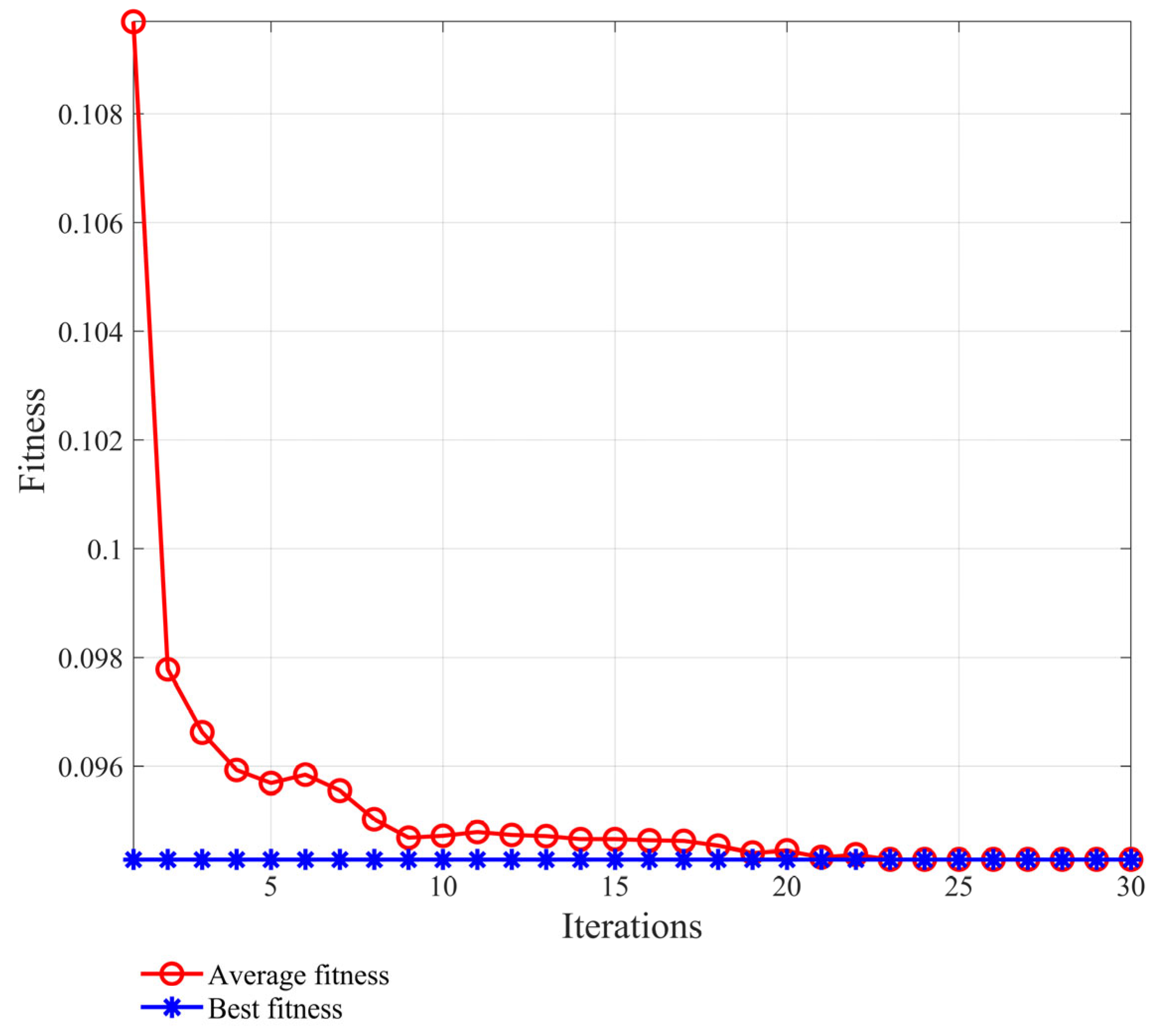
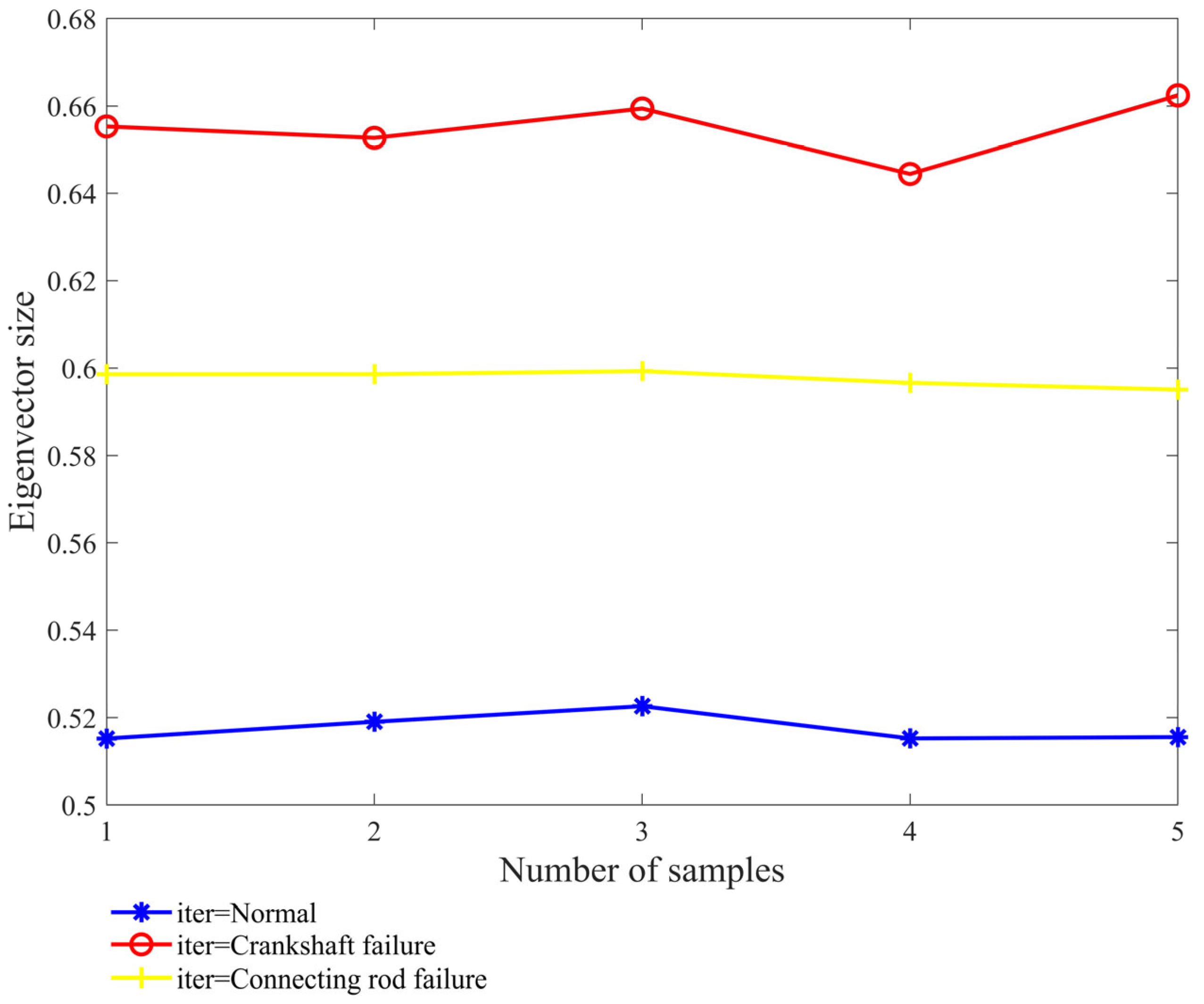
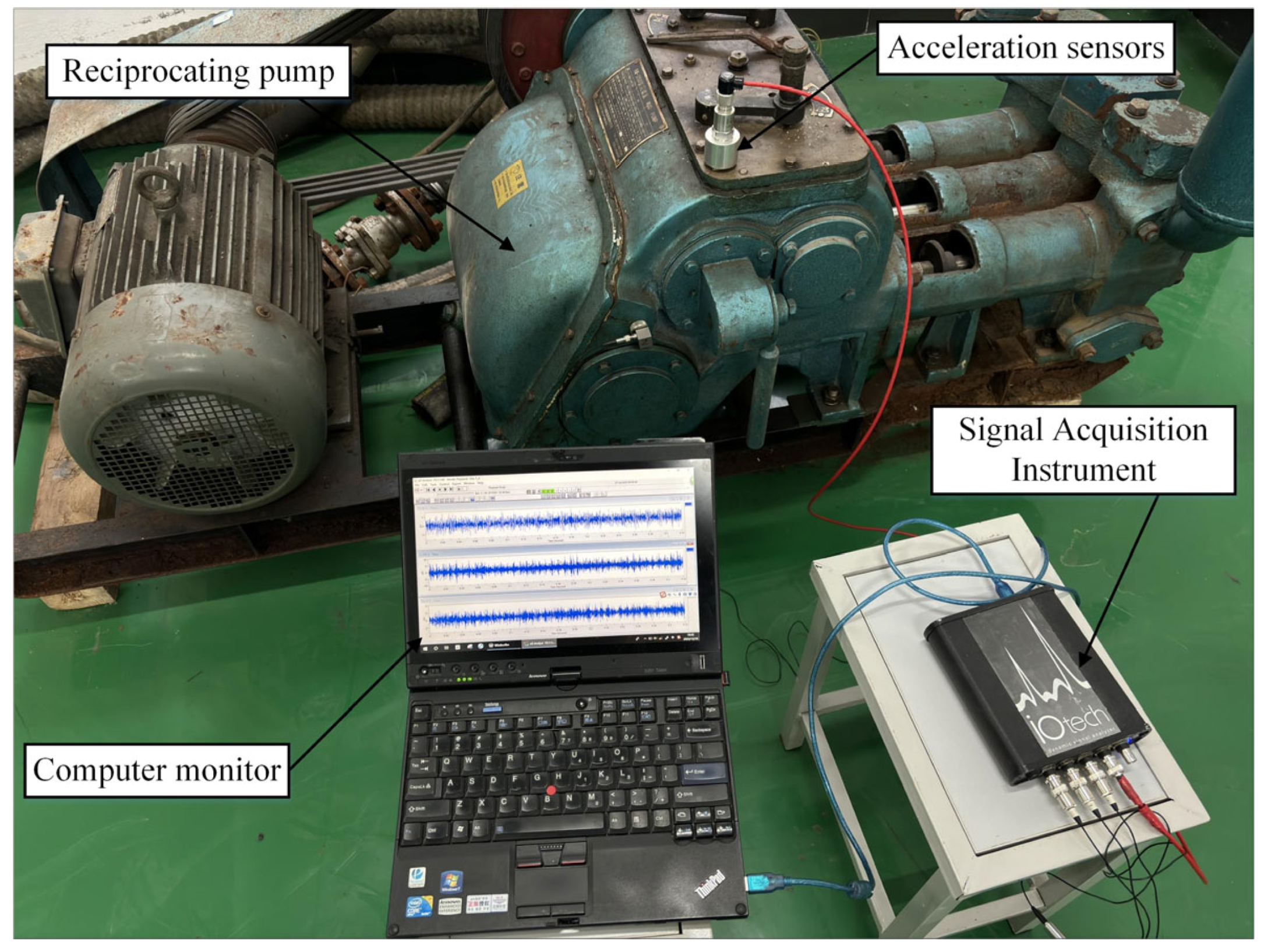

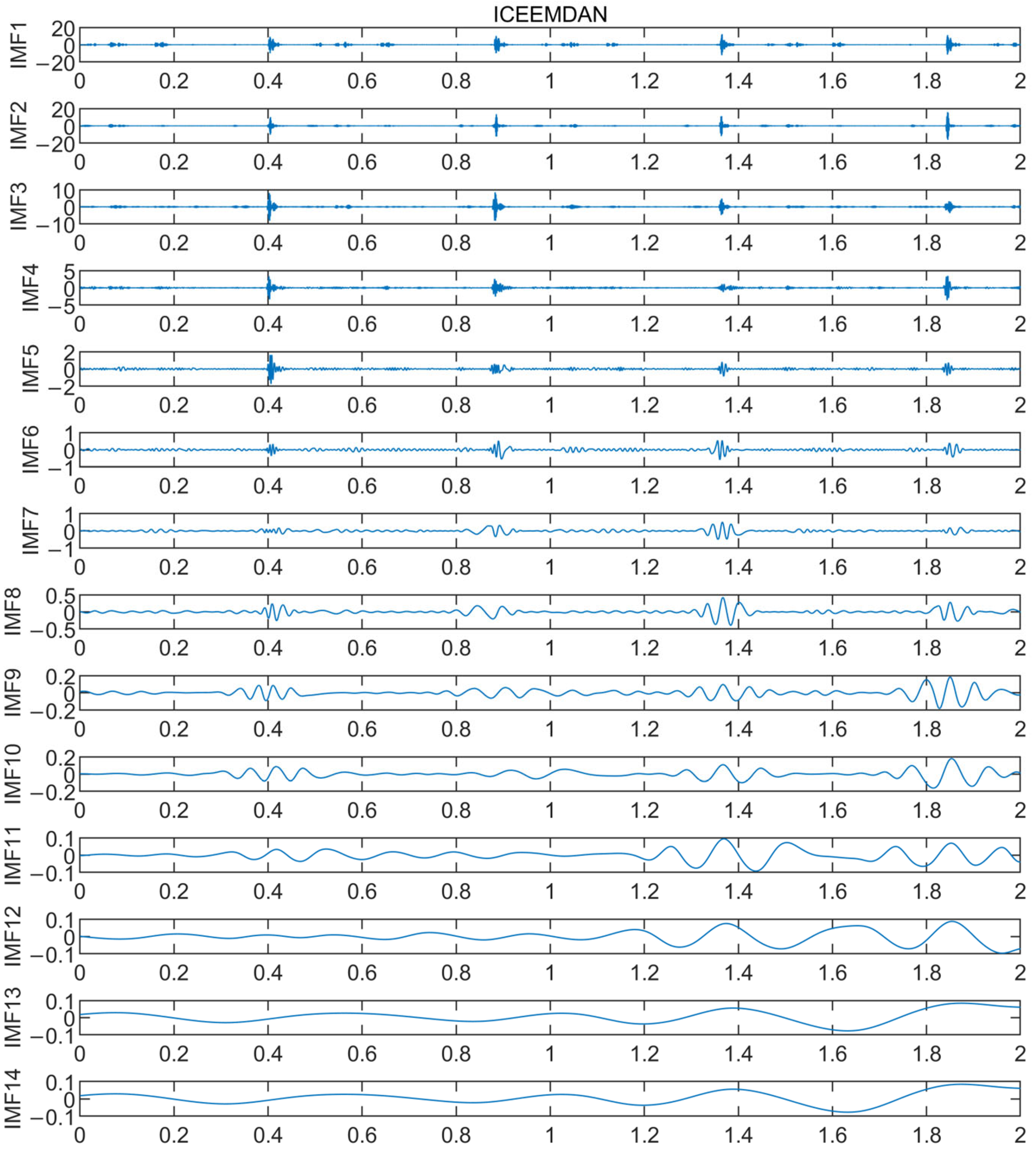
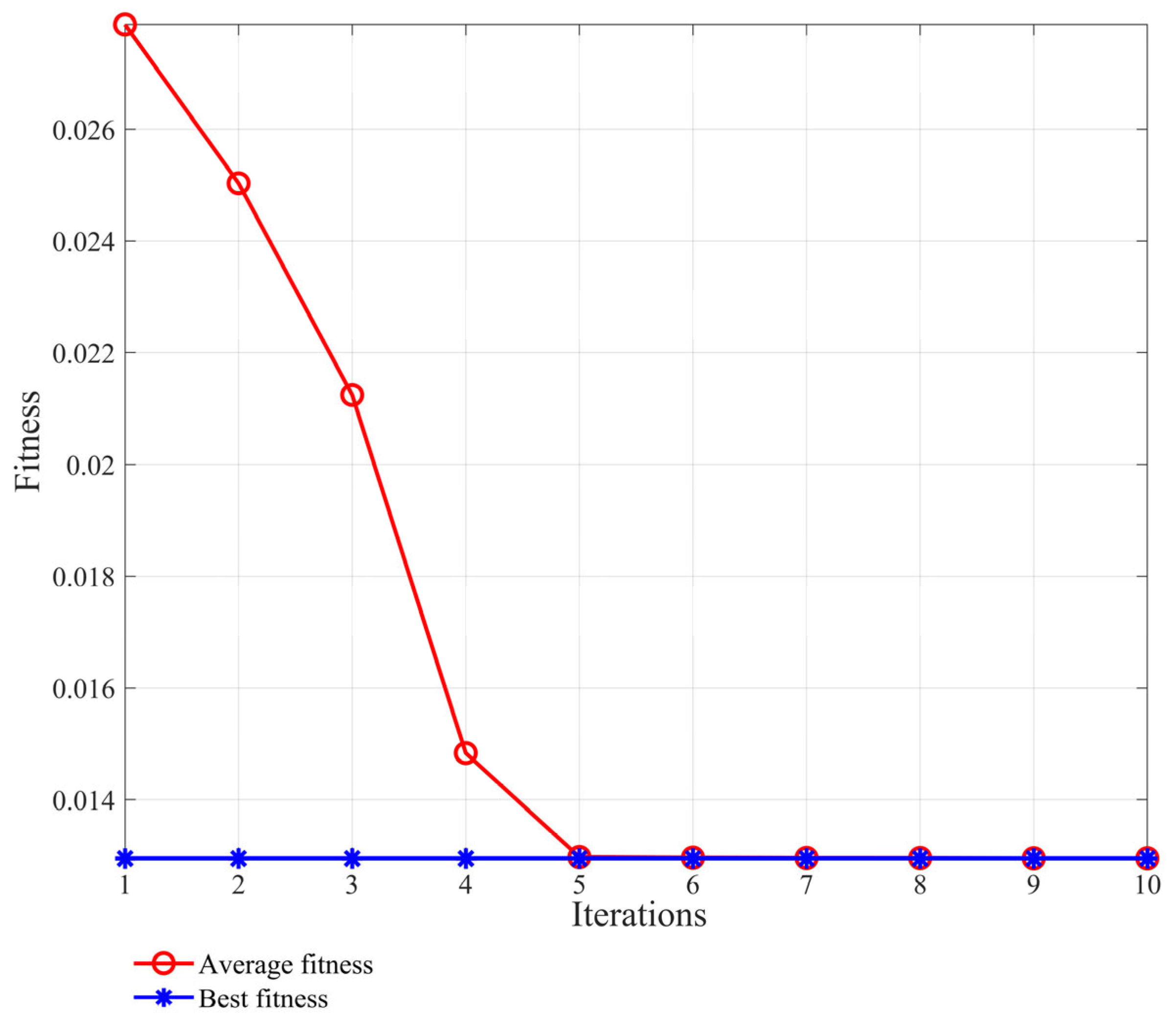
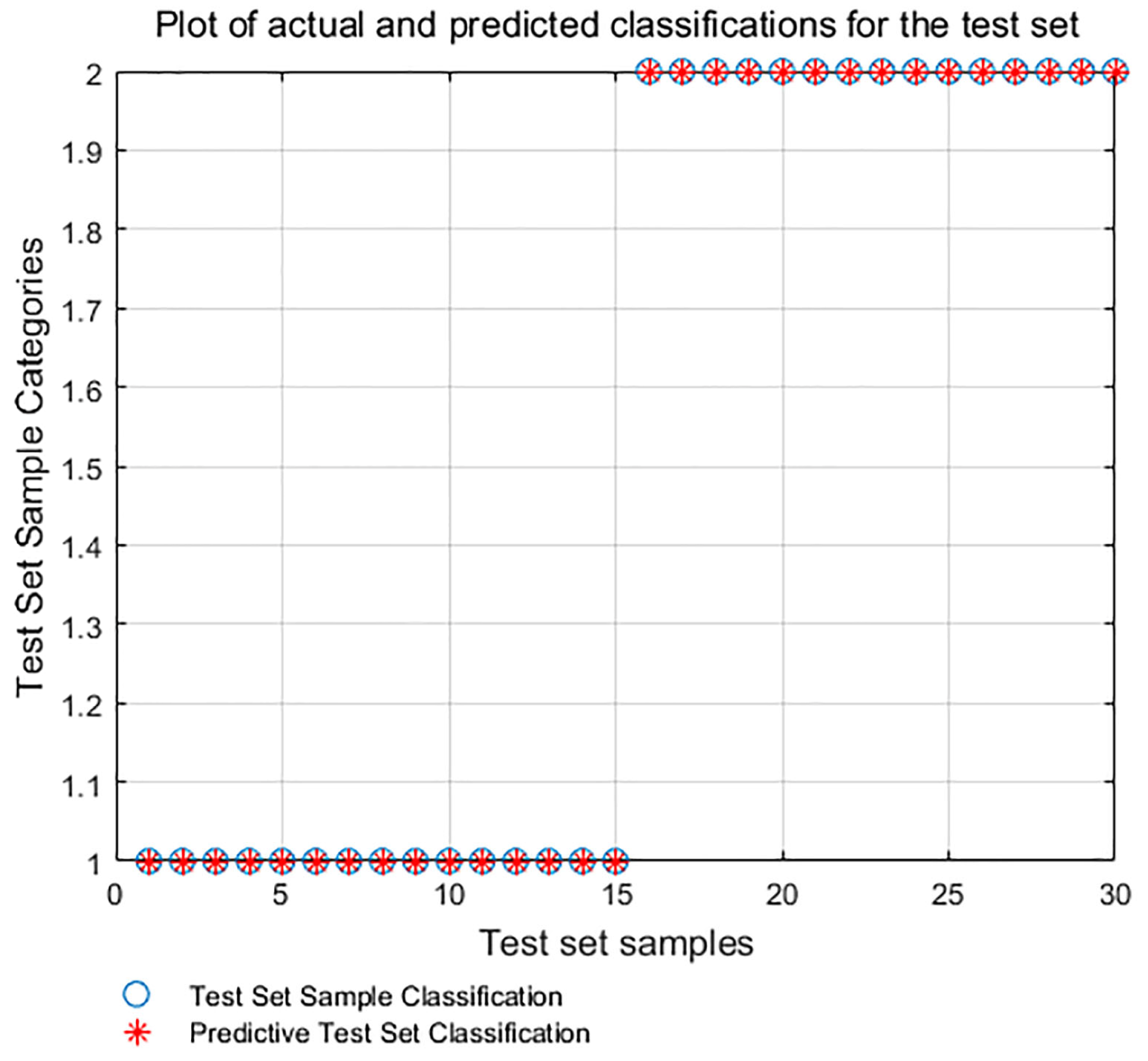

| Name | Size/mm | Name | Size/mm |
|---|---|---|---|
| Bearing journal diameter | 300 | Outer diameter of connecting rod big end | 1100 |
| Axial length of bearing journal | 155 | Axial length of connecting rod big end | 200 |
| Main journal diameter | 325 | Inner diameter of connecting rod big end | 950 |
| Axial length of main journal | 153 | Outer diameter of connecting rod small end | 280 |
| Inner diameter of eccentric | 325 | Axial length of connecting rod small end | 175 |
| Eccentric axial length | 136 | Inner diameter of connecting rod small end | 143 |
| External diameter of eccentric | 740 | Total length of connecting rod | 2010 |
| Diameter of outer arc end of crosshead | 452.4 | Internal length of crosshead arc | 260 |
| Outer diameter width of crosshead | 295 | Inner diameter width of crosshead | 295 |
| External axial length of crosshead | 456 | Internal axial length of crosshead | 400 |
| Crosshead pin diameter | 143 | Axial length of crosshead pin | 343 |
| Diameter of intermediate rod hole | 180 | Axial length of intermediate rod hole | 30 |
| Connecting Rod-Eccentric Wheel | Stiffness Coefficient | Damping Coefficient | Collision Parameters | Static Friction Factor | Dynamic Friction Factor |
|---|---|---|---|---|---|
| parameter | 2.1 × 106 | 2.1 × 104 | 1.5 | 0.1 | 0.05 |
| Crankshaft fault | IMF1 | IMF2 | IMF3 | IMF4 |
| 22.959 | 16.227 | 8.733 | 3.316 | |
| IMF5 | IMF6 | IMF7 | IMF8 | |
| 1.683 | 2.249 | 2.128 | 1.760 |
| State | IMF1 | IMF2 | IMF3 | IMF4 |
|---|---|---|---|---|
| Normal | 0.5152 | 0.5196 | 0.4961 | 0.3628 |
| 0.5191 | 0.5193 | 0.4974 | 0.3666 | |
| 0.5226 | 0.5221 | 0.4489 | 0.3628 | |
| 0.5152 | 0.5165 | 0.4833 | 0.3628 | |
| 0.5155 | 0.5180 | 0.5048 | 0.3628 | |
| Crankshaft wear | 0.6553 | 0.6521 | 0.6379 | 0.5061 |
| 0.6527 | 0.6359 | 0.6295 | 0.4937 | |
| 0.6594 | 0.6533 | 0.6410 | 0.4250 | |
| 0.6444 | 0.6511 | 0.6284 | 0.4362 | |
| 0.6624 | 0.6364 | 0.6154 | 0.4013 | |
| Connecting rod wear | 0.5986 | 0.5944 | 0.5647 | 0.5196 |
| 0.5986 | 0.5954 | 0.5665 | 0.5312 | |
| 0.5993 | 0.5941 | 0.5636 | 0.5244 | |
| 0.5966 | 0.5947 | 0.5756 | 0.5343 | |
| 0.5951 | 0.5950 | 0.5613 | 0.5256 |
| Crankshaft fault | IMF1 | IMF2 | IMF3 | IMF4 | IMF5 | IMF6 | IMF7 |
| 52.062 | 132.520 | 77.403 | 53.159 | 42.920 | 15.252 | 12.807 | |
| IMF8 | IMF9 | IMF10 | IMF11 | IMF12 | IMF13 | IMF14 | |
| 11.172 | 7.186 | 6.388 | 4.256 | 3.465 | 2.860 | 1.618 |
| State | Variable | s = 1 | s = 2 | s = 3 | s = 4 | s = 5 | s = 6 | s = 7 | s = 8 | Mean Value |
|---|---|---|---|---|---|---|---|---|---|---|
| Normal | m = 1 | 0.914 | 0.878 | 0.827 | 0.768 | 0.740 | 0.734 | 0.696 | 0.685 | 0.7801 |
| m = 2 | 0.865 | 0.844 | 0.806 | 0.776 | 0.760 | 0.715 | 0.707 | 0.667 | 0.7673 | |
| m = 3 | 0.839 | 0.799 | 0.777 | 0.741 | 0.742 | 0.700 | 0.659 | 0.676 | 0.7417 | |
| m = 4 | 0.716 | 0.767 | 0.765 | 0.760 | 0.731 | 0.714 | 0.681 | 0.685 | 0.7273 | |
| m = 5 | 0.519 | 0.767 | 0.784 | 0.756 | 0.726 | 0.714 | 0.692 | 0.660 | 0.7023 | |
| m = 6 | 0.332 | 0.482 | 0.613 | 0.639 | 0.679 | 0.668 | 0.678 | 0.667 | 0.5947 | |
| Fault | m = 1 | 0.904 | 0.921 | 0.881 | 0.907 | 0.859 | 0.827 | 0.793 | 0.804 | 0.8621 |
| m = 2 | 0.878 | 0.850 | 0.906 | 0.836 | 0.803 | 0.840 | 0.828 | 0.764 | 0.8382 | |
| m = 3 | 0.614 | 0.804 | 0.834 | 0.795 | 0.833 | 0.809 | 0.818 | 0.755 | 0.7827 | |
| m = 4 | 0.474 | 0.613 | 0.700 | 0.762 | 0.809 | 0.742 | 0.657 | 0.696 | 0.6816 | |
| m = 5 | 0.322 | 0.437 | 0.548 | 0.584 | 0.626 | 0.722 | 0.716 | 0.764 | 0.5899 | |
| m = 6 | 0.270 | 0.352 | 0.427 | 0.473 | 0.536 | 0.593 | 0.655 | 0.635 | 0.4926 |
Disclaimer/Publisher’s Note: The statements, opinions and data contained in all publications are solely those of the individual author(s) and contributor(s) and not of MDPI and/or the editor(s). MDPI and/or the editor(s) disclaim responsibility for any injury to people or property resulting from any ideas, methods, instructions or products referred to in the content. |
© 2024 by the authors. Licensee MDPI, Basel, Switzerland. This article is an open access article distributed under the terms and conditions of the Creative Commons Attribution (CC BY) license (https://creativecommons.org/licenses/by/4.0/).
Share and Cite
Bie, F.; Shu, Y.; Lyu, F.; Liu, X.; Lu, Y.; Li, Q.; Zhang, H.; Ding, X. Research on a Fault Diagnosis Method for Crankshafts Based on Improved Multi-Scale Permutation Entropy. Sensors 2024, 24, 726. https://doi.org/10.3390/s24030726
Bie F, Shu Y, Lyu F, Liu X, Lu Y, Li Q, Zhang H, Ding X. Research on a Fault Diagnosis Method for Crankshafts Based on Improved Multi-Scale Permutation Entropy. Sensors. 2024; 24(3):726. https://doi.org/10.3390/s24030726
Chicago/Turabian StyleBie, Fengfeng, Yu Shu, Fengxia Lyu, Xuedong Liu, Yi Lu, Qianqian Li, Hanyang Zhang, and Xueping Ding. 2024. "Research on a Fault Diagnosis Method for Crankshafts Based on Improved Multi-Scale Permutation Entropy" Sensors 24, no. 3: 726. https://doi.org/10.3390/s24030726
APA StyleBie, F., Shu, Y., Lyu, F., Liu, X., Lu, Y., Li, Q., Zhang, H., & Ding, X. (2024). Research on a Fault Diagnosis Method for Crankshafts Based on Improved Multi-Scale Permutation Entropy. Sensors, 24(3), 726. https://doi.org/10.3390/s24030726








